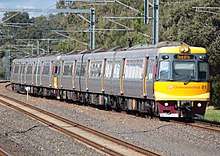Rail transport in the Netherlands
| The Netherlands | |||||||
|---|---|---|---|---|---|---|---|
 | |||||||
| Operation | |||||||
| National railway | Nederlandse Spoorwegen | ||||||
| Infrastructure company | Railinfratrust | ||||||
| Major operators |
NS International Arriva Connexxion Syntus Transdev | ||||||
| Statistics | |||||||
| Ridership | 438 million per year | ||||||
| Passenger km | 17.1 billion per year[1] | ||||||
| Freight | 36.5 million ton per year | ||||||
| System length | |||||||
| Total | 3,223 kilometres (2,003 mi)[2] | ||||||
| Double track | 1,982 kilometres (1,232 mi) | ||||||
| Electrified | 2,321 kilometres (1,442 mi)[2] | ||||||
| Freight only | 158.5 km | ||||||
| High-speed | 125 km | ||||||
| Track gauge | |||||||
| Main | 1,435 mm (4 ft 8 1⁄2 in) | ||||||
| High-speed | 1,435 mm (4 ft 8 1⁄2 in) | ||||||
| Electrification | |||||||
| 1.5 kV DC | Main network | ||||||
| 25 kV AC | HSL-Zuid, Betuweroute | ||||||
| Features | |||||||
| No. tunnels | 13 | ||||||
| Longest tunnel | Groeneharttunnel, 7160 meters | ||||||
| No. bridges | 4500 (of which 76 are movable) | ||||||
| No. stations | 408 | ||||||
| |||||||
Rail transport in the Netherlands uses a dense railway network, that connects virtually all major towns and cities, counting as many train stations as there are municipalities in the Netherlands. The network totals 3,223 route km, (which represents 6,830 kilometres of track[3] as there can be a line running both ways, or two lines running each way on important routes) three quarters of which has been electrified.[2]
The Dutch rail network supports predominantly passenger transport[4] and also most distance travelled on Dutch public transport is done by rail.[5] The national rail infrastructure is managed and maintained by public task company ProRail, and a number of different operators have concessions to run their trains.[6] The entire network is standard gauge.
The Netherlands is a member of the International Union of Railways (UIC). The UIC Country Code for the Netherlands is 84.
Operators

Public transport authorities in the Netherlands issue concessions for collections of lines.[7]
- Nederlandse Spoorwegen (NS; Dutch Railways) – services the main passenger rail network (Hoofdrailnet), including a limited night service (see below)
- Arriva Netherlands – the northern secondary lines around Leeuwarden and Groningen, some eastern secondary lines around Arnhem and Zutphen, the southern secondary lines in Limburg, and one central secondary line.
- Breng – services a part of an eastern secondary line (second operator on this line, in addition to Arriva)
- Keolis – services two eastern secondary lines, between Zwolle and Kampen, and Zwolle and Enschede, and one secondary line as Syntus, between Zutphen and Oldenzaal.
- Connexxion – services one secondary line, between Ede-Wageningen and Amersfoort
- NS International in international trains, and domestic high speed service Intercity Direct
A few Dutch railway stations are serviced, even for journeys within the country, from foreign railway operators using the NS authorization:
- DB Regio, including DB Regionalbahn Westfalen and DB Euregiobahn
- NMBS/SNCB – Maastricht – Eijsden, as part of the Maastricht – Liège service
Nationwide a common fare system applies although operators tend to use separate tariffs due to the concession system.
Most trains consist of both 1st and 2nd class compartiments; Syntus and occasionally Arriva only offer 2nd class compartiments.
The largest cargo carrier in the Netherlands is DB Schenker, others are ACTS, Crossrail, ERS Railways, Häfen und Güterverkehr Köln, Rail4chem and Veolia Cargo.
The whole network itself is maintained from the public owned agency ProRail, which is also responsible for allocating slots to the different companies.
History
The first Dutch railway was built and opened in 1839, on a short stretch between Amsterdam and Haarlem, and was expanded between 1840 and 1847 to The Hague and Rotterdam.[8] It was originally built to a broad gauge of 1,945 mm (6 ft 4 9⁄16 in), but was converted to 1,435 mm (4 ft 8 1⁄2 in) (standard gauge) in 1866.[9] Further expansion happened in the 19th century to connect the rest of the country. During the 20th century most of the main lines were electrified, starting in 1908 with the Hofpleinlijn. From 1922 (after a report by a government commission) the 1.5 kV DC system with overhead catenary was used.
Network
The network is heavily focused on passenger rail services and connects virtually all major cities, although there are still a few cities without a train connection, including Nieuwegein, Drachten, Amstelveen, Oosterhout, and Katwijk.
Most freight routes run east-west, connecting the Port of Rotterdam and Koninklijke Hoogovens in IJmuiden with Germany. Freight trains usually share the tracks with passenger trains; the only exception is the new Betuweroute, which opened in 2007 as the first freight-only route.
The network is well developed and dense. No extensions are currently planned. One focuses on upgrading the network in terms of efficiency and capacity. More over, some sections might need an increase of the maximum speed up to 160 km/h.
Some important new lines were built in recent years, however. These include the HSL-Zuid high speed line, the Betuweroute and the Hanzelijn, connecting the province of Flevoland with the railway node Zwolle.
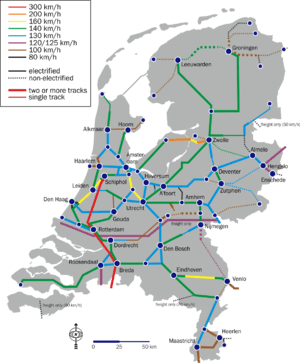
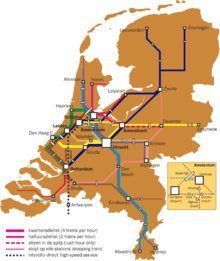
Most of the network is electrified at 1.5 kV DC, which limits interoperability with neighbouring countries, although Belgian trains (built for 3 kV DC) can run on the Dutch network at reduced power. Both the HSL-Zuid and the Betuweroute have been electrified at 25 kV AC; and though conversion of existing electrified lines to 25 kV AC was considered in 1997, 2005 and 2012 (to cost over €10bn), a 2015 proposal (revised in 2017) is to convert to 3 kV DC (2017 cost €1bn). The higher DC voltage would reduce power losses and have faster acceleration above 60 to 70 km/h so that stopping trains would save 7 to 20 seconds per stop.[10]
Speed is generally limited to 130–140 km/h, but on most secondary lines actual maximum speed is significantly lower. On the HSL-Zuid line, the maximum speed is much higher at 300 km/h. Technically, more recent lines have been constructed to allow for higher speeds. An overview of maximum speeds on all lines is available in the Train routes in the Netherlands article.
Trains are frequent, with one or two trains per hour on lesser lines, two to four trains per hour on rural sections and up to 8 or 10 trains an hour in urban regions. One could distinguish two types of trains: stoptreinen (local trains, which call at all stations; Dutch Railways tend to call them Sprinters) and intercities, providing faster long-distance services. An intermediate category of sneltreinen (fast trains) is being phased out, starting in 2007, although regional operators continue to use this brand. One could barely distinguish differences between sneltrein and the intercities, so removing the sneltrein could be considered as a kind of rebranding.
The railways of the Netherlands are all 1,435 mm (4 ft 8 1⁄2 in) (standard gauge),[9] and they have a total length of 3,061 route-kilometers or 7,028 track-kilometers.[6] 2061 kilometers are electrified (2001) at 1500 volt DC.[11] Only 931 km is single track. The country counts 2,589 level crossings, of which 1,598 are protected.[12] In the railway system are 7,071 switch tracks, 12,036 signals, 725 rail viaducts, 455 rail bridges, of which 56 are movable, and 15 tunnels.[12]
ProRail maintains Dutch railway network infrastructure (except metros and tram infrastructure), allocating rail capacity, and traffic control. The rail capacity supplied by ProRail is used by five public transport operators (see below) as well as cargo operators: DB Schenker, ERS, ACTS, Rail4Chem. Aside from these, there are a few negligible operators, amongst whom for example Herik Rail, with seven carriages, where trains can be chartered for parties, meetings, etc.[13]
Recent and new tracks
- Betuweroute, A freight line from Rotterdam to Germany, (electrified at 25 kV AC).
- Hemboog between Schiphol/Amsterdam-Lelylaan and Zaandam, bypassing the crossing at Amsterdam Sloterdijk.[14] It provides a direct connection between Schiphol and Zaandam/Hoorn. Technically it also allows for a direct train service from Schiphol to Alkmaar, but such a service is not provided yet.
- Gooiboog between Hilversum/Naarden-Bussum and Almere Muziekwijk.[15]
- Utrechtboog between Schiphol/Amsterdam-Rai and Bijlmer/Utrecht, bypassing the crossing at Duivendrecht.[15][16]
- The HSL-Zuid (electrified at 25 kV AC; see below)
- The Lelystad–Zwolle railway ("Hanzelijn") between Lelystad-Dronten-Kampen-Zwolle.
- Railway between Maastricht and Lanaken (B) re-built (2007–2009).
Two stations are have a bilevel crossing of lines rather than a level junction or double junction requiring protection by signals; Amsterdam Sloterdijk and Duivendrecht. Other Dutch line crossings have grade separation, see flying junction.
Non-electrified lines
(with timetable number)
- Groningen-Delfzijl 84
- Groningen-Roodeschool 83
- Groningen-Nieuweschans Grens 85
- Leeuwarden-Groningen 80
- Leeuwarden-Harlingen 81
- Leeuwarden-Stavoren 82
- Almelo-Marienberg 72
- Zutphen-Hengelo 73
- Enschede-Glanerbrug Grens 522
- Zutphen-Apeldoorn 67
- Zutphen-Winterswijk 71
- Arnhem-Winterswijk 70
- Arnhem-Tiel 68
- Nijmegen-Roermond 29 (Approved for electification)[17]
- Landgraaf-Landgraaf Grens 525 (Electrification planned, was due 2017)
Rolling stock
The dutch railways has a wide array of rolling stock used today. The intercity trains have the well known Yellow and Blue coloursscheme, whilst the sprinters use the blue, white & yellow colours.
Current fleet
| Class | Image | Type | Speed (km/h) | Amount | Cars | Operation | Built | Notes | |
|---|---|---|---|---|---|---|---|---|---|
| Top | Operating | ||||||||
| ICM |  |
EMU | 180 | 140 | 144 | 3 or 4 | Intercity | 1977–present | |
| VIRM |  |
200 | 140 | 178 | 4 or 6 | 1994–present | |||
| DDZ | 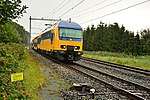 |
140 | 50 | 4 or 6 | 1991–1998 | Formerly known as DD-AR, refurbished 2010–2013. Only refurbished trains in use. | |||
| Intercityrijtuig |  |
Carriage | 160 | 43 | n\a | 1980–1988 | In use by the high-speed Intercity Direct (Amsterdam-Schiphol-Rotterdam-Breda) and Intercity International to Brussels | ||
| SGM |  |
EMU | 120 | 90 | 2 or 3 | Sprinter | 1975–1983 | ||
| SLT |  |
160 | 140 | 131 | 4 or 6 | 2007–2012 | |||
| FLIRT |  |
160 | 140 | 54 | 3 or 4 | 2016–2017 | Used in North Brabant and Limburg. | ||
| Class 186 (TRAXX) | 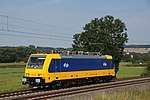 |
Electric Locomotive | 160 | 63 | n/a | Intercity (International) | 2008–present | Used to pull/push the ICR Carriages on the International route to brussels via the HSL-Zuid | |
Future fleet
| Class | Image | Type | Speed (km/h) | Amount | Cars | Operation | Built | Notes | |
|---|---|---|---|---|---|---|---|---|---|
| Top | Operating | ||||||||
| ICNG | 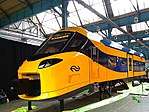 |
EMU | 200 | 200 | 79 | 5 or 8 | Intercity | 2017–2023 | Will be put into service in 2021 and will run 200km/h on High-Speed tracks and 160 km/h on regular tracks. |
| SNG |  |
160 | 140 | 118 | 3 or 4 | Sprinter | 2014–2018 | Will be put into service in 2018 | |
Railway links with adjacent countries
The Dutch network has several cross-border sections to Belgium[18] and Germany.[19] Of these, Terneuzen is linked to Belgium (freight-only), but not to the rest of the Dutch network. Contrarily, Lanaken (B) is connected to Maastricht (also freight only) but not to the Belgian network. Six cross-border links are electrified. Due to the difference in voltage, trains must change monovoltage locomotives at Bad Bentheim or Venlo; monovoltage Belgian 3 kV trains reach Roosendaal and Maastricht with reduced power. The HSL Zuid has no voltage change at the border itself. Alternatively, multi-system train units or diesel traction is used. Several border crossings are disused or freight-only. There are no breaks of gauge at any of the crossings.
To Germany, north to south:
- Bad Nieuweschans – Not electrified. Due to a damaged bridge unused since 3 December 2015.
- Ter Apel – German side never finished, Dutch side dismantled only a few years after construction.
- Coevorden – Not electrified, goods only.
- Bad Bentheim – Voltage change 1.5 kV DC/15 kV AC.
- Enschede – To Gronau, not electrified. The track itself is no longer connected to the Dutch network, so no through traffic is possible.
- Broekheurne, south of Enschede – dismantled.
- Winterswijk
- Emmerich – Voltage change 25 kV AC/15 kV AC, allowing only multi-system or diesel trains.
- Zevenaar – Kleve – Dismantled. Branching off from the line Zevenaar – Emmerich, when border operations were still handled on the Dutch side of the border.
- Nijmegen – Disused.
- Gennep – Dismantled, site of the German invasion of the Netherlands in 1940.
- Venlo
- Vlodrop-station – Iron Rhine. Disused, but reactivation under study.
- Heerlen – Not electrified.
- Simpelveld – Not electrified, heritage trains only, not connected to the German network.
To Belgium, east to west:
- Maastricht
- To Visé – Voltage change 1.5 kV DC/3 kV DC. Voltage change is some distance away from the border, so that Eijsden railway station is on the Dutch side of the border, but on the Belgian side of the voltage change.
- To Lanaken – Not electrified, goods only. There is no connection to the Belgian network.
- Neerpelt
- To Weert – Iron Rhine. Not electrified, goods only.
- To Valkenswaard – Dismantled.
- Baarle-Nassau – Dismantled. Strictly speaking nine border crossings, as the railway repeatedly passed in and out of Baarle-Hertog.
- Breda – Electrified at 25 kV AC, high-speed railway.
- Roosendaal – Voltage change 1.5 kV DC/3 kV DC.
- Hulst – Dismantled.
- Sas van Gent – Not electrified, goods only.
International trains
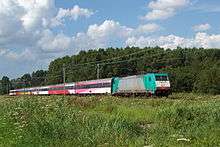
- Intercity Amsterdam Central – Schiphol – The Hague HS – Rotterdam Central – Antwerp-Central – Brussels-Central – Brussels-South
- Thalys: Amsterdam Central – Schiphol Airport – Rotterdam Central – Antwerp-Central – Brussels-South – Paris North
- The train is able to use 1500 volt DC (France, Netherlands), 3000 volt DC (Belgium) and 25000 volt AC 50 Hz (France and high-speed lines).
- High-speed between Amsterdam and Antwerp, and between Brussels and Paris.
- In the winter and summer holiday seasons, an additional weekly train runs onward to respectively Bourg-Saint-Maurice and Marseille
- Intercity "Berlijn": Amsterdam Central – Amersfoort -Deventer – Hengelo – Osnabrück Central – Hannover Central – Berlin Central
- ICE: from Amsterdam to Frankfurt Hbf, Germany and Basel SBB, Switzerland
- CityNightLine from Amsterdam to Munich, Germany and Vienna Westbf, Austria
- There are several regional cross-border connections.[20]
See also Rail transport by country, Europe.
Night service
NS offers a limited night service (Nachtnet).
On five nights a week it is just a single U-shaped stretch with an hourly service connecting Rotterdam Central, Delft, The Hague Central, Leiden Central, Schiphol Airport, Amsterdam Central, Utrecht Central (i.e., most of the large cities in the Randstad as well as the main airport). Due to the U-shape, journey time from the first five stations to Utrecht is longer than during day service. Because the relatively short distance between the stations, no separate sleepers are used.
During weekends night services are extended to Dordrecht and four cities in the Province of North Brabant.
On Friday and Saturday nights there is an additional service between Rotterdam and Amsterdam.
| Series | Route | Material | Frequency |
|---|---|---|---|
| 1400/21400 | (Eindhoven – Tilburg – Breda – Dordrecht -) Rotterdam Centraal – Delft – Den Haag HS – Leiden Centraal – Schiphol – Amsterdam Centraal – Utrecht Centraal (- 's-Hertogenbosch – Eindhoven) | VIRM | 1x per hour – operates between Eindhoven and Rotterdam/Utrecht Friday, Saturday nights only |
| 21420 | 's-Hertogenbosch – Tilburg | 1x per hour, Friday, Saturday nights only |
"Friday night" means the night between Friday and Saturday, etc.
Fares and tickets
Nationwide a common fare system applies, Via NS ticket machines, although operators tend to use separate fares due to the concession system and the recently introduced public transport card, which allows ticket integration and price differentiation.
Travellers need to be aware of the various operators. For off-peak pass subscribers, a station where one has to change operator one suffers barriers during peak hours.
Classical paper printed tickets were abolished as of 9 July, 2014. Nowadays ticket machines sell card board tickets containing an electric chip, but one has to pay a surcharge of € 1,- per ticket compared to the regular public transport card fees. These surcharge also applies on tickets sold via counters.
Passengers not carrying a valid ticket receive a €50,- fine plus the fare, unless the ticket machines were all out of order or some other exemption applies. The fine has to be paid at once except if the passenger is able to provide a valid identification card, in which case one can receive a collection notice in the mail. Travellers from abroad, commencing their Dutch train journey at Schiphol need to know that they have to buy a ticket before boarding the train.
One could buy on-line tickets through the Dutch Railways website, but payment can only be made via a Dutch Bank account. A workaround is to buy Dutch domestic train tickets online at the Belgian Railways website, which is able to sell these as it is part of the Benelux ticketing system, accepts major credit cards, and issues Dutch domestic fares as print-at-home tickets.
Off-peak discount passes
Counted as off-peak hours are weekdays 0:00–6:34:59, 8:55–16:04:59 and 18:25–24:00[21] and on Saturdays and Sundays the whole day. With a discount product on the pass one is automatically granted the discount based on the type of the discount product and the time of checking in. The term discount includes 100% discount, i.e. free travel.
There is an Off-Peak Discount Pass (in Dutch: Dal Voordeel) for €50,- / year, allowing a 40% discount on journeys starting in off-peak hours. Up to 4 people could enjoy the reduced far if they are in possession of a public transport card.
For a single € 14,- supplement, people over 60 years grant for free travel during off-peak hours on 7 days a year. Apart from some restrictions these subscribers could upload these free travel journeys themselves. One could only buy this supplement once a year.
There is also an Off-Peak Free Pass (in Dutch: Dal Vrij) for €99,-/ month (minimum 1-year subscription), allowing free journeys which each start in the off-peak hours (compare the OV-Jaarabonnement).[22] Here "journey" refers to a journey with a single operator. Thus, for free travel, changing to a train of a different operator has to be in the off-peak hours too.
For €309,- / month (minimum 1-year subscription), travelers can buy Altijd Vrij, for unlimited all day traveling.
Use of all these passes requires checking in at the beginning of a journey and checking out at the end, otherwise the traveller risks a fine.
Regulations involving time periods:
- 100 seconds: minimum time between checking in and out or out and in for NS, except if another card reader is used
- 2–3 minutes:[23] minimum time between checking in and out or out and in, except for NS; for Arriva one minute less
- 5 minutes: margin in favor of traveller applied to times of start and end of off-peak hours, compared to those published (above this margin is already taken into account); (confirmed for all operators except Connexxion)
- 30 minutes: maximum allowed time between checking in and scheduled departure time of the train (applies to NS; for other operators unknown)
- 1 hour: maximum allowed time between checking in and out at the same station without travelling; this is free of charge (applies to NS; for other operators unknown); for the holder of the Off-Peak Free Pass who checks in during off-peak hours there is no time limit, except in the case of checking in for Connexxion
- 6 hours: maximum allowed time between checking in and checking out (applies to NS; Arriva: 4 hours; for other operators unknown)
Railways in the Dutch Caribbean
Saba, Sint Eustatius and Bonaire (the Caribbean Netherlands) have no railways, and there are no railways at Sint Maarten and Curaçao. There is a local tram service on Aruba, introduced in 2012 and operated by bus company Arubus. Construction took place in cooperation with Haguish tramway company HTM. Rolling stock consists of one open, non-articulated single-decker and two open double-deckers.[24] These trams run on standard gauge. Two industrial narrow-gauge railway lines have existed on Aruba, but those have been removed.[25]
See also
References
- ↑ "Railways, passengers carried (million passenger-km)". worldbank.org. Archived from the original on 17 August 2015.
- 1 2 3 "CIA World Factbook | Field listing: Railways". www.cia.gov. U.S. Central Intelligence Agency. 2014. Retrieved 2015-08-17.
- ↑ Hofland, Dick (3 October 2014). "125 jaar Amsterdam Centraal" [Amsterdam Central station 125 years] (in Dutch). Sanoma Media Netherlands. Retrieved 4 October 2014.
- ↑ "Nederlandse spoor zeer intensief gebruikt" [Dutch railtracks intensely used]. www.treinreiziger.nl (in Dutch). Dutch Central Bureau of Statistics (CBS). 1 March 2009. Retrieved 2014-07-09.
- ↑ Waard, Jan van der; Jorritsma, Peter; Immers, Ben (October 2012). "New Drivers in Mobility: What Moves the Dutch in 2012 and Beyond?" (PDF). Delft, the Netherlands: OECD International Transport Forum. Archived from the original (PDF) on 2013-01-17. Retrieved 2014-07-07.
- 1 2 "Kerncijfers".
- ↑ Concessions; see also nl:Concessies in het Nederlandse openbaar vervoer#Overzicht concessies.
- ↑ "Nederland komt op stoom". Spoor (in Dutch). Nederlandse Spoorwegen. 2014 (3): 46–47. September 2014.
- 1 2 From 1839 until 1864 it was 1,945 mm (6 ft 4 9⁄16 in), see 1,945 mm (6 ft 423⁄40 in) and "Parovoz". Archived from the original on 11 January 2013. , it was changed because Germany and Belgium had 1,435 mm (4 ft 8 1⁄2 in), see komlos spatial1
- ↑ "Making the case for 3 kv DC" in Railway Gazette International (England): March 2017 (Vol 173 No 3) pages 50–53
- ↑ Elektrificatie Nederland
- 1 2 "ProRail in cijfers" [ProRail in numbers] (in Dutch). ProRail. 2017. Retrieved 2018-08-20.
- ↑ A complete list of licensed operators can be found at europa.eu Archived 2007-03-19 at the Wayback Machine.
- ↑ "sporenplan w". sporenplan.nl. Archived from the original on 4 May 2001.
- 1 2 "sporenplan o". sporenplan.nl. Archived from the original on 24 July 2001.
- ↑ (in Dutch) utrechtboog
- ↑ "Elektrificatie Maaslijn definitief". OV-Magazine.
- ↑ Thorsten Büker. "border lines – Belgium – Netherlands". bueker.net.
- ↑ Thorsten Büker. "border lines – Netherlands – Germany". bueker.net.
- ↑ For an overview of both passenger and freight traffic, see Belgium-Netherlands and Netherlands-Germany.
- ↑ taken into account the 5 minutes margin mentioned below
- ↑ q42. "Season tickets". 9292.nl.
- ↑ Three minutes on a clock that ignores seconds, for example from 12:34:56 until 12:37:00
- ↑ "Aruba trams".
- ↑ "Auba and Aruban History". Retrieved 2010-12-19.
External links
| Wikimedia Commons has media related to Rail transport in the Netherlands. |
| Wikivoyage has a travel guide for Rail travel in the Netherlands. |
- ProRail railway map
- http://www.sporenplan.nl/html_nl/sporenplan/ns/ns_normaal/start.html – Schematic maps of all tracks, switches and platforms:
- http://kubus.mailspool.nl/spoorkaart Live map of locations of moving passenger trains
- http://www.prorail.nl/Vervoerders/Infrastructuur/Documents/R-Overzicht%20Functionaliteitswijzigingen%20en%20Indienststellings-data%20Infraprojecten%20tot%20en%20met%202017.pdf – planning of changes in infrastructure

